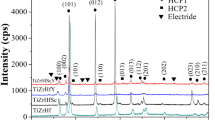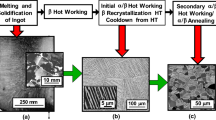Abstract
This study investigates the effect of deformation temperature, strain rate, and strain on the deformation behavior above and below the beta (β) transus temperature (Tβ), as well as the alpha (α) + β microstructure evolution, in Ti-17 alloy during deformation and subsequent cooling to room temperature. Dynamic recovery is the dominant restoration mechanism of the β matrix during hot deformation above and below the Tβ, which leads to the formation of subgrain structure under applied conditions. During deformation at temperatures less than the Tβ, the α phase precipitates at β grain boundaries initially in a globular or film shape (GBα), followed by the formation of Widmanstätten α (Wα) plates from the GBα and inside the β grains. The α precipitation kinetics is accelerated by increasing the deformation strain during deformation at temperatures less than the Tβ. Even at temperatures greater than the Tβ, deformation is found to induce α-phase precipitation at β boundaries. Further, α-phase precipitation occurs during slow cooling after deformation, whereas greater deformation strain leads to a decrease in the total α-phase fraction because the enrichment of Mo and Cr and the depletion of Al in the β phase by the formation of Wα at higher temperatures stabilizes the β phase and thus suppresses the subsequent β → α transformation during cooling.














Similar content being viewed by others
References
R.R. Boyer and H.W. Rosenberg: Beta titanium alloys in the 80’s, Proceedings of the Symposium, Atlanta, GA, 1983. USA, 1984.
G. Welsch, R. Boyer, and E.W. Collings: Materials Properties Handbook: Titanium Alloys, ASM international, Metals Park, 1993.
3 G. Lütjering: Mater. Sci. Eng. A, 1998, vol. 243, pp. 32–45.
4 I. Weiss and S.L. Semiatin: Mater. Sci. Eng. A, 1998, vol. 243, pp. 46–65.
5 H. Matsumoto, D. Naito, K. Miyoshi, K. Yamanaka, A. Chiba, and Y. Yamabe-Mitarai: Sci. Technol. Adv. Mater., 2017, vol. 18, pp. 893–904.
6 J. Xu, W. Zeng, Y. Zhao, Z. Jia, and X. Sun: J. Alloys Compd., 2016, vol. 673, pp. 86–92.
7 J. Xu, W. Zeng, Y. Zhao, and Z. Jia: Mater. Sci. Eng. A, 2016, vol. 676, pp. 434–40.
Y. Yamabe-Mitarai, S. Kuroda, N. Motohashi, H. Matsumoto, G. Miyamoto, E. Chandiran, Y. Yoshida, and Y. Itsumi: Mater. Trans., 2019, vol. 60, pp. 1733–39.
Z. Mu, H. Li, and M.Q. Li: Mater. Sci. Eng., A, 2013, vol. 582, pp. 108–16.
10 X. Shi, W. Zeng, and Q. Zhao: Mater. Sci. Eng. A, 2015, vol. 636, pp. 543–50.
11 J.D.C. Teixeira, B. Appolaire, E. Aeby-Gautier, S. Denis, G. Cailletaud, and N. Späth: Mater. Sci. Eng. A, 2007, vol. 448, pp. 135–45.
12 J.D.C. Teixeira, B. Appolaire, E. Aeby-Gautier, S. Denis, and L. Héricher: Comput. Mater. Sci., 2008, vol. 42, pp. 266–80.
Y. Nagata, G. Miyamoto and T. Furuhara: Proc. 9th Pacific Rim Int. Conf. Adv. Mater. Process., 2016, pp. 654–7.
R.T. DeHoff and F.N. Rhines: Quantitative Microscopy, Mcgraw-Hill,New York, 1968.
15 L. Li, M.Q. Li, and J. Luo: Mater. Sci. Eng. A, 2015, vol. 628, pp. 11–20.
S.M. Abbasi, M. Morakkabati, A.H. Sheikhali, and A. Momeni: Metall. Mater. Trans. A, 2014, vol. 45, pp. 5201–11.
17 O.N. Senkov and J.J. Jonas: Metall. Mater. Trans. A 1996, vol. 27, pp. 1877–87.
18 A.W. Sleeswijk: Acta Met., 1958, vol. 6, pp. 598-602.
19 P. Rodriguez: Bull. Mater. Sci., 1984, vol. 6, pp. 653–63.
F. Montheillet, L. Pallot, and D. Piot: in Materials Science Forum, vol. 706, Trans Tech Publ, 2012, pp. 127–34.
21 T. Furuhara, B. Poorganji, H. Abe, and T. Maki: Jom, 2007, vol. 59, pp. 64–7.
22 M. Kamaya, A.J. Wilkinson, and J.M. Titchmarsh: Acta Mater., 2006, vol. 54, pp. 539–48.
23 M. Calcagnotto, D. Ponge, E. Demir, and D. Raabe: Mater. Sci. Eng. A, 2010, vol. 527, pp. 2738–46.
24 B. Liu, H. Matsumoto, Y. Koizumi, Y. Liu, and A. Chiba: Mater. Trans., 2012, vol. 53, pp. 1007–10.
25 B. Liu, Y. Li, H. Matsumoto, Y. Koizumi, Y. Liu, and A. Chiba: Adv. Eng. Mater., 2012, vol. 14, pp. 785–9.
26 A. Dehghan-Manshadi, and R.J. Dippenaar: 2012. Mater. Sci. Eng. A, 2012, vol. 522, pp.451-456.
27 K. Hua, X. Xue, H. Kou, J. Fan, B.Tang, and J. Li, J. Alloys Comp., 2014, Vol.615, pp.531-537.
E. Chandiran, G. Miyamoto, and T. Furuhara: The 14th World Conference on Titanium, MATEC Web of Conferences, 2020, 321, 12006.
29 W.G. Burgers, Physica. 1934, Vol.1, pp. 561-586.
R.H. Buzolin, D. Weiß, A. Krumphals, M. Lasnik, and M.C. Poletti. Metall Mater Trans A, vol. 51, pp. 3967–80 (2011).
Acknowledgment
This work was supported by Japan Science and Technology (JST) through “Cross-ministerial Strategic Innovation Promotion Program Cabinet Office, Government of Japan, Structural Materials for Innovation (SIP-SM4I)” and ISIJ Innovative Program for Advanced Technology by Iron and Steel Institute of Japan (ISIJ).
Author information
Authors and Affiliations
Corresponding author
Additional information
Publisher's Note
Springer Nature remains neutral with regard to jurisdictional claims in published maps and institutional affiliations.
Manuscript submitted November 9, 2020; accepted April 22, 2021.
Supplementary Information
Below is the link to the electronic supplementary material.
Appendix
Appendix
1.1 A.1 β Transus Temperature
To determine the β transus temperature, Tβ, Ti-17 samples were isothermally maintained at various temperatures ranging from 900 °C to 550 °C in a salt bath for different time periods to obtain the equilibrium phase fraction, followed by water quenching. The α-phase fraction was then determined from SEM images using the point-counting method and plotted as a function of temperature in Figure A1. With increasing temperature, the α-phase fraction decreases. At ~ 880 °C, the α-phase fraction becomes negligibly smaller, indicating that the Tβ of the present Ti-17 alloy is 880 ± 2 °C. The following equation to describe the equilibrium α-phase volume fraction (Vα) as a function of temperature (T) was obtained by fitting:
1.2 A.2 Expected Temperature Along the Radial Direction of the Sample
Directly measuring the temperature along the radial direction of the sample during thermomechanical processing is difficult. Therefore, we used an indirect method to estimate the temperature distribution. Cylindrical specimens of Ti-17 alloy with dimensions corresponding to those of the 0 pct deformed specimen (height 12 mm and diameter 8 mm, Figure A2(a)) and the 70 pct deformed specimen (height 3.6 mm and diameter 14.6 mm, Figure A2(b)) were prepared using a wire-cut electric discharge machine. These specimens were heated to 800 °C and maintained at this temperature for 2 hours, which was sufficiently long to reach an equilibrium α fraction under an applied load ranging between 0 and 300 N (i.e., a stress level between 0 and 7 MPa), followed by gas quenching. The heat-treated specimen was cut parallel to the compression axis, and a series of SEM micrographs were taken along the radial direction of the heat-treated specimens at the mid-height region. Then α-phase fraction was determined by the point-counting method and is shown in Figures A2(c) and (d) (solid lines). On the basis of Eq. [A1], the α-phase fraction was converted into temperature, which is represented by the dashed line in Figures A2(c) and A2(d). In the specimen with the original shape (H12 mm × ϕ8 mm), as shown in Figure A2)(a, the α-phase fraction ranges from 30 to 33 pct along the radial direction. The deviation between the programmed (800 °C) and actual temperatures (estimated from the α fraction) was typically 10 °C in this case. By contrast, in a shorter specimen (H 3.6 mm × ϕ14.6 mm), the α-phase fraction was higher at the center region (~ 45 pct) of the specimen than at the outer region along the radial direction (~ 35 pct). For such a higher α phase in the center region, the required decrease in temperature is ~ 40 °C from 800 °C. These results suggest that the temperature deviation along the radial direction increases with increasing deformation strain during thermomechanical processing.
Schematics of specimens whose dimensions correspond to the (a) 0 pct deformed and (b) 70 pct deformed conditions. Measured α-phase fraction and estimated temperature along the radial direction of specimens heat-treated at 800 °C for 2 h and whose dimensions correspond to the (c) 0 pct deformed and (d) 70 pct deformed conditions
Rights and permissions
About this article
Cite this article
Chandiran, E., Nagata, Y., Sun, F. et al. Effect of Deformation Temperature, Strain Rate, and Strain on the Microstructure Evolution of Ti-17 Alloy. Metall Mater Trans A 52, 3107–3121 (2021). https://doi.org/10.1007/s11661-021-06305-6
Received:
Accepted:
Published:
Issue Date:
DOI: https://doi.org/10.1007/s11661-021-06305-6






